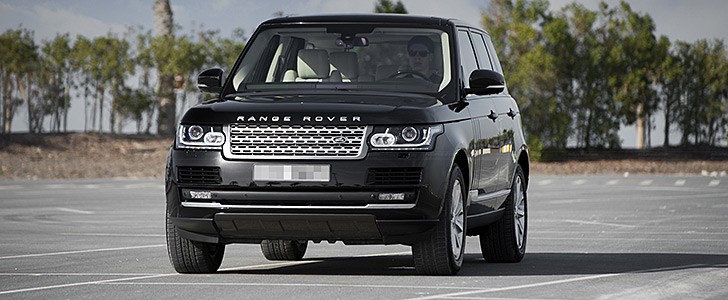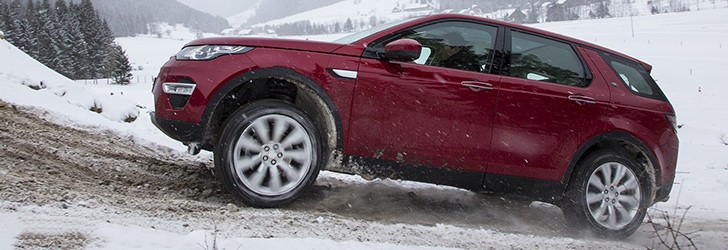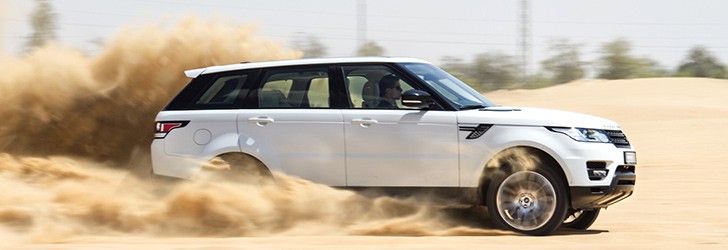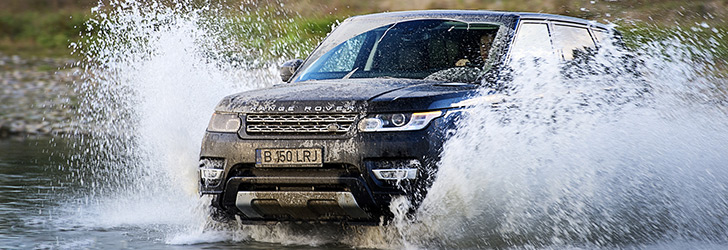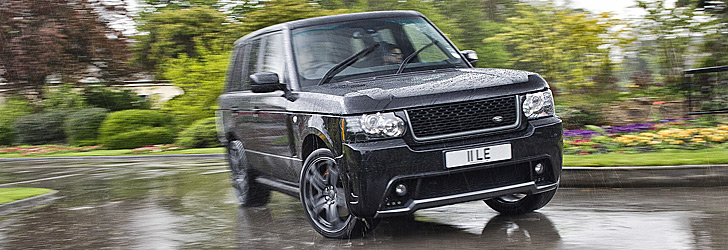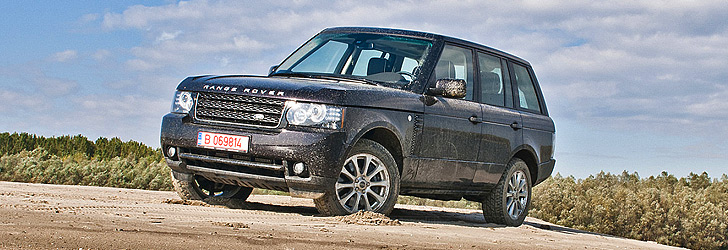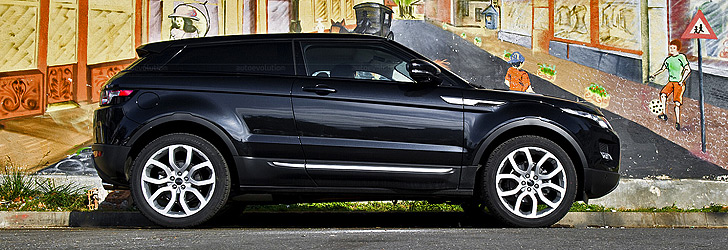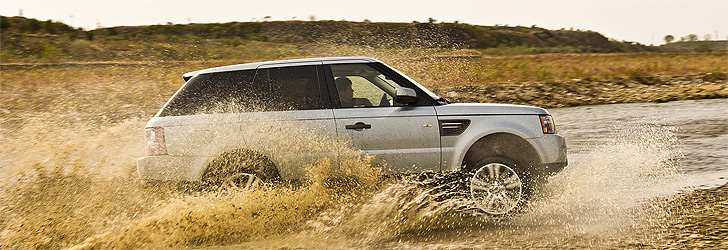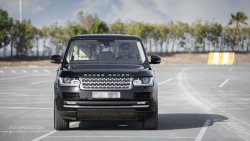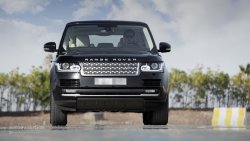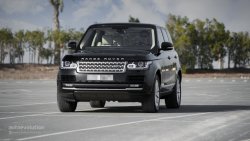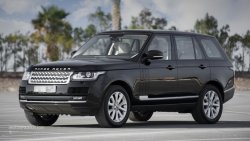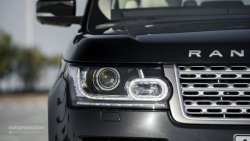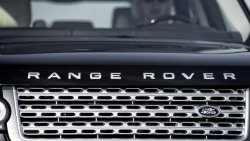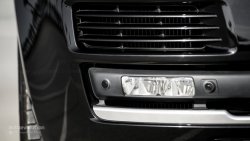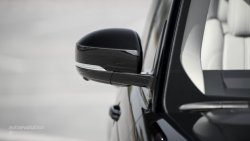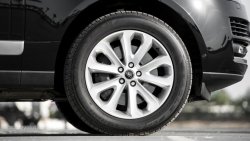Range Rover Supercharged Review
OUR TEST CAR: Range Rover 5.0 Supercharged 2013
The previous generation of the Range Rover has turned the model into a machine that provides limo comfort at height. The new model brings all sorts of technological advances on the table, so it promises to score better.
The interior space now comes in even greater abundance, with the rear passengers benefiting most from the increase - the legroom is vastly improved and the headroom is also more generous. In addition, the entry/exit is facilitated by the lower access height of the air suspension, as well as by the larger doors.
As you are installed in your armchair, you notice the Stonehenge-sized hood and the Range Rover feeling - floating above all else - installs. We could ask for softer headrest and more modern armrests though. As for the rear seating, you can order an Executive Class pack - this brings individual reclining rear seats with memory and massage, also offering a superior range of veneers.
The soundproofing is excellent: there is a bit of wind noise from the massive mirrors, but the only thing that truly manages to enter the cabin is a mannered V8 soundtrack that appears at generous throttle applications.
Of course, you only need to push the pedal in this way if you're looking for absurd speeds. For normal driving, the Range Rover Supercharger's throttle can be handled with touches so delicate that they're barely noticeable.
The audio calibration perfectly expresses the nature of the car - the 510 horses are allowed to slightly bring their presence inside the cabin, while the exhaust is completely muted.
The Range Rover Supercharged now uses an eight-speed gearbox, which, among others, brings an extra touch of refinement though its closer ratios.
Literally above all, sits a panoramic sunroof that prides itself with the title of the largest ever fitted to a Range Rover. Together with the generous glasshouse, this brings an explosion of light inside the car. One interesting detail is the fact that the textile inner layer of the roof seems to be extremely vulnerable to wear and tear.
There are a few problems of the previous generation that are still present, such as the cover for the luggage compartment. This is just as difficult to fold or handle as it was in the old Range Rover.
But these elements can be overlooked by many owners. Alas, the Range Rover has an Achilles' heel that can't. You can take this in the literal sense, as we're referring to the suspension here.
The Range Rover uses a reworked version of the replaced model's suspension, which mixes air springs with adaptive dampers. Engineers brag that this has been recalibrated for working with a monocoque chassis, but there is one big issue: whenever you reach a more serious obstacle, the ride becomes crashy.
The entire structure is briefly but firmly shaken and since the problem follows you wherever you go, on and off the road, this takes serious points of the Range Rover's otherwise excellent comfort score.
Body and Chassis
Land Rover has left behind the ladder chassis structure of the Range Rover, replacing this with an all-aluminum monocoque. The new chassis structure, which derives from that of the Jaguar XJ, is 39 percent lighter compared to the one it supersedes - it tips the scales at about 400 lbs (180 kg) lower.
The various parts of the shell that need to be connected are riveted and bonded together without any spot welding.
In order to reduce weight, Land Rover also used aluminum for the doors and side intrusion beams, composite reinforced B-posts protection elements, as well as for the front and rear sub frames and for the final drive unit. What's more, the entire side of the car uses a one-piece aluminum panel.
The overall weight savings brought by the monocoque aluminum construction climb up to 770 lbs (350 kg), depending on the model. We have to explain that Land Rover offers a maximum value of 925 lbs (420 kg), but this doesn't follow the like-for-like principle, referring to the TDV6 diesel model compared to the previous generation's TDV8.
Powertrain
The range-topping Supercharged model has kept its engine, which means that we get the same blown 4,999 cc V8. Just like before, the direct-injected unit delivers 510 hp between 6,000 and 6,500 rpm, while the maximum torque of 461 lb-ft (625 Nm) arrives between 2,500 and 5,500 rpm.
The previous-generation Range Rover made use of the eight-speed ZF gearbox but the supercharged engine wasn't on the list of units that received it, having to make due with a six-speed ZF automatic. Now the 8HP7 unit has made its way into the forced induction powertrain.
This gearbox shift times sit at 200 ms and it does allow the driver to perform multiple downshifts via the steering wheel-mounted paddles. The unit features a Transmission Idle Control feature that disconnects 70 percent of the drive when the car is not on the move, with the engine idling in "Drive".
The All-Wheel Drive hardware has also been borrowed from the replaced model. This means that we receive a bevel gear center differential - an electronically-controlled multi-plate clutch varies the torque distribution, which normally sits at 50:50. There's also a two-speed transfer case, which can swap ranges up to 37 mph (60 km/h).
Road Connection
The Range Rover has received an all-new aluminum suspension layout: the front axle employs a double-wishbone design, while the rear one features a multi-link scheme. Among other characteristics of the new design is an impressive amount of wheel travel: 10.2 inches (260 mm) up front and 12.2 inches (310 mm) at the back.
The rest of the suspension, including the adaptive dampers and the interlinked air springs, has been carried out from the replaced model, but features a revised setup.
Land Rover has gifted the car with electric power-assisted steering (EPAS), just like in the case of the Evoque. The car maker brags that replacing the hydraulic system alone saves 3 percent in terms of CO2 emissions.
The EPAS can offer various level of feedback depending on the grip offered by the driving surface, which means that this now works in conjunction with the Range Rover's Terrain Response system. The new steering system also allows the Range Rover to offer a Park Assist automated parallel parking function.
Stopping power
The Range Rover uses 380 mm front discs and 365 mm rear rotors, with the front axle benefiting from Brembo six-piston calipers.
When choosing the exterior shade of a Range Rover you have more possibilities than just selecting a color - you can also play with the roof, adding a contrasting finish and/or a panoramic sunroof. For the ultimate level of color choices, you’ll have to look at the Autobiography trim level, which offers 22 unique finishes.
Land Rover wanted the new model to follow the current trends and offer a higher level of personalization. Thus, apart from the aforementioned choices, customers can also opt for illuminated tread plates, as well as for electrically deployable side steps and tow bar (offered separately).
Depending on the market, you can gift the car with wheels ranging between 19 and 22 inches in diameter.
As for the interior color configuration, the cabin of the Range Rover is spread in multiple areas: the lower zone, the seats, the door panels, lower dashboard and center console, as well as the veneers and the headliner.
The climate control system is offered in two versions, one with three zones and one with four areas, also offering a Park Heating timer feature.
Since the Range Rover has become more of a luxury car than an offroader, you can also choose special seating options, such as a massage feature and an Executive rear seat pack.
There are also other premium features that boost the plush feeling offered by the car: keyless entry, soft door close, as well as power upper and lower tailgates.
In terms of providing an audio experience, the Range Rover turns to British specialist Meridian, offering three levels for the audio system. The highest one will bring you the 1,700W Signature Reference system, which spreads no less than 29 speakers, including a subwoofer, across the cabin of the SUV.
This easily tops the Harman Kardon system, the highest option available, of the previous generation Range Rover, which provided proper quality, but lacked high-end bass capabilities.
On the safety features front, the Range Rover offers Blind Spot Monitoring with Closing Vehicle Sensing, Reverse Traffic Detention, which warns the driver of potential accident during reversing and a Surround Camera System.
Land Rover also gifted the car with Intelligent Emergency Braking and Adaptive Cruise Control, with the latter incorporating Queue Assist - this can bring the car to a complete stop if the traffic requires it.
The Range Rover relies on multiple technologies to handle various driving conditions, including Dynamic Response with Active Lean Control, as well as on Adaptive Dynamics (adaptive dampers). As with the previous model, there’s also an optional Active Rear Locking Differential, which assists the Active Center Locking diff.
The fourth generation of the Range Rover ups the ante on the personalization front compared to its predecessor, also upgrading the rest of the features at a moderate level.
The Range Rover had to roll up its sleeves and enter the Euro NCAP testing facility late last year, with the vehicle showing mixed results.
The "big picture" crash test rating for this Land Rover looks excellent: five stars, a 91 percent rating for adult occupant protection, 84 percent for child occupant protection, 63 percent for pedestrians and 86 percent for the safety assist area. Unfortunately, the numbers don’t tell the full story, which is a rather... ahem... twisted one.
When it came to the frontal impact and standard side impact tests, the Range Rover did very well. The vehicle showed it can offer “good” protection (the highest rating available) for all areas of the driver’s and passenger’s bodies. The only exception was the torso of the driver, which received “adequate” protection during the frontal impact.
Things took a turn for the worse when it came to the more serious side pole test, where the chest area only received “marginal” protection, while the rest of the body areas were treated with a “good” rating.
When it came to the rear impact test, the “marginal” rating once again appeared - this is the protection offered against whiplash injury.
In terms of child occupant protection, the Range Rover managed to score maximum points for the protection of the 18 months infant. During the frontal impact, there was no excessive movement for the 3-year dummy sitting in a forward-facing restraint. As for the side impact, both dummies were well protected, being properly held in their shells. The vehicle did lose some points in the end, due to improper labeling for disabling the passenger airbag.
The Range Rover’s stance makes the sheer thought of a pedestrian crash frightening, but the car proved that new technology can change things.
The bumper received maximum points for the protection offered to pedestrians’ legs, while the areas of the bonnet that may be hit by the head of an adult or a child offered mainly “good” protection. Alas, engineering is not magic and so the front edge of the bonnet didn’t get any points for pedestrian protection.
From behind the wheel, the Range Rover offers a feeling of security thanks to its specific high driving position, its size, as well as its soundproofing.
However, this is not matched by the steering, which offers a shockingly detached feeling and when we add this to the considerable ride height of the car, we end up with a driving experience that only gives one confidence if the speed is kept well in check. Since we mentioned this, we have to explain that in the Supercharged version we drove, it is fairly easy for the car to slip way past the speed limit without the driver noticing.
The fourth generation of Land Rover's flagship vehicle forgets the "ranger's Rover" attitude of the previous models, being conceived as a luxurious vehicle with offroad aptitudes, not the other way around.
Land Rover has split the creation process between borrowing the Jaguar XJ's aluminum chassis and further developing all the areas of the SUV. Thus, despite sharing its platform, albeit in an altered form, with a luxury sedan, the new Range Rover is one of the cars with the greatest engineering density available.
As for the financial side of the deal, the Range Rover Supercharged has a MSRP of $99,995, including destination and delivery taxes. Should your dealer be located in Europe, you'll be required to pay at least EUR113,600 including 19 percent VAT.
The best part of the Range Rover is, as always, its presence. Despite the luxury aura involution brought by both the exterior and the interior styling, this Land Rover still has an image as strong as the rocks it can crawl.
Speaking of climbing, we have to mention that all the innovations built into the car make it even more capable of tackling rugged terrain.
The on-road driving experience brings a similar conclusion, with the vehicle being more ready than ever to mix luxury with ground clearance. The supercharged V8 is relentless in delivering power and now that it has less weight to carry around it can truly serve your needs.
Alas, you can't exploit the aforementioned potential properly due to one issue: the suspension can't handle more serious obstacles, so when it encounters one you'll feel a small accident has taken place.
This isn't even the only problem with the Range Rover's suspension. Even the stiffer setup of the Supercharged model we drove is still packed with roll, pitch and dive. Add the total absence of steering feel to this and you'll end up with a driving experience that can become unpleasant at times.
On paper, the Range Rover is one of the best cars the world has ever seen. In the real world though, the British SUV fails to excel due to its compromised nature. Its predecessor had more flaws, but it was regarded as a rugged machine adapted for everyday use, so, unlike now, they could be forgived.
The Range Rover, be it Supercharged or not, is probably going to convince plenty of customers, mainly due to its aforementioned image. However, we don't see any context in which we could recommend it.
The interior space now comes in even greater abundance, with the rear passengers benefiting most from the increase - the legroom is vastly improved and the headroom is also more generous. In addition, the entry/exit is facilitated by the lower access height of the air suspension, as well as by the larger doors.
As you are installed in your armchair, you notice the Stonehenge-sized hood and the Range Rover feeling - floating above all else - installs. We could ask for softer headrest and more modern armrests though. As for the rear seating, you can order an Executive Class pack - this brings individual reclining rear seats with memory and massage, also offering a superior range of veneers.
The soundproofing is excellent: there is a bit of wind noise from the massive mirrors, but the only thing that truly manages to enter the cabin is a mannered V8 soundtrack that appears at generous throttle applications.
Of course, you only need to push the pedal in this way if you're looking for absurd speeds. For normal driving, the Range Rover Supercharger's throttle can be handled with touches so delicate that they're barely noticeable.
The audio calibration perfectly expresses the nature of the car - the 510 horses are allowed to slightly bring their presence inside the cabin, while the exhaust is completely muted.
The Range Rover Supercharged now uses an eight-speed gearbox, which, among others, brings an extra touch of refinement though its closer ratios.
Literally above all, sits a panoramic sunroof that prides itself with the title of the largest ever fitted to a Range Rover. Together with the generous glasshouse, this brings an explosion of light inside the car. One interesting detail is the fact that the textile inner layer of the roof seems to be extremely vulnerable to wear and tear.
There are a few problems of the previous generation that are still present, such as the cover for the luggage compartment. This is just as difficult to fold or handle as it was in the old Range Rover.
But these elements can be overlooked by many owners. Alas, the Range Rover has an Achilles' heel that can't. You can take this in the literal sense, as we're referring to the suspension here.
The Range Rover uses a reworked version of the replaced model's suspension, which mixes air springs with adaptive dampers. Engineers brag that this has been recalibrated for working with a monocoque chassis, but there is one big issue: whenever you reach a more serious obstacle, the ride becomes crashy.
The entire structure is briefly but firmly shaken and since the problem follows you wherever you go, on and off the road, this takes serious points of the Range Rover's otherwise excellent comfort score.
Body and Chassis
Land Rover has left behind the ladder chassis structure of the Range Rover, replacing this with an all-aluminum monocoque. The new chassis structure, which derives from that of the Jaguar XJ, is 39 percent lighter compared to the one it supersedes - it tips the scales at about 400 lbs (180 kg) lower.
The various parts of the shell that need to be connected are riveted and bonded together without any spot welding.
In order to reduce weight, Land Rover also used aluminum for the doors and side intrusion beams, composite reinforced B-posts protection elements, as well as for the front and rear sub frames and for the final drive unit. What's more, the entire side of the car uses a one-piece aluminum panel.
The overall weight savings brought by the monocoque aluminum construction climb up to 770 lbs (350 kg), depending on the model. We have to explain that Land Rover offers a maximum value of 925 lbs (420 kg), but this doesn't follow the like-for-like principle, referring to the TDV6 diesel model compared to the previous generation's TDV8.
Powertrain
The range-topping Supercharged model has kept its engine, which means that we get the same blown 4,999 cc V8. Just like before, the direct-injected unit delivers 510 hp between 6,000 and 6,500 rpm, while the maximum torque of 461 lb-ft (625 Nm) arrives between 2,500 and 5,500 rpm.
The previous-generation Range Rover made use of the eight-speed ZF gearbox but the supercharged engine wasn't on the list of units that received it, having to make due with a six-speed ZF automatic. Now the 8HP7 unit has made its way into the forced induction powertrain.
This gearbox shift times sit at 200 ms and it does allow the driver to perform multiple downshifts via the steering wheel-mounted paddles. The unit features a Transmission Idle Control feature that disconnects 70 percent of the drive when the car is not on the move, with the engine idling in "Drive".
The All-Wheel Drive hardware has also been borrowed from the replaced model. This means that we receive a bevel gear center differential - an electronically-controlled multi-plate clutch varies the torque distribution, which normally sits at 50:50. There's also a two-speed transfer case, which can swap ranges up to 37 mph (60 km/h).
Road Connection
The Range Rover has received an all-new aluminum suspension layout: the front axle employs a double-wishbone design, while the rear one features a multi-link scheme. Among other characteristics of the new design is an impressive amount of wheel travel: 10.2 inches (260 mm) up front and 12.2 inches (310 mm) at the back.
The rest of the suspension, including the adaptive dampers and the interlinked air springs, has been carried out from the replaced model, but features a revised setup.
Land Rover has gifted the car with electric power-assisted steering (EPAS), just like in the case of the Evoque. The car maker brags that replacing the hydraulic system alone saves 3 percent in terms of CO2 emissions.
The EPAS can offer various level of feedback depending on the grip offered by the driving surface, which means that this now works in conjunction with the Range Rover's Terrain Response system. The new steering system also allows the Range Rover to offer a Park Assist automated parallel parking function.
Stopping power
The Range Rover uses 380 mm front discs and 365 mm rear rotors, with the front axle benefiting from Brembo six-piston calipers.
When choosing the exterior shade of a Range Rover you have more possibilities than just selecting a color - you can also play with the roof, adding a contrasting finish and/or a panoramic sunroof. For the ultimate level of color choices, you’ll have to look at the Autobiography trim level, which offers 22 unique finishes.
Land Rover wanted the new model to follow the current trends and offer a higher level of personalization. Thus, apart from the aforementioned choices, customers can also opt for illuminated tread plates, as well as for electrically deployable side steps and tow bar (offered separately).
Depending on the market, you can gift the car with wheels ranging between 19 and 22 inches in diameter.
As for the interior color configuration, the cabin of the Range Rover is spread in multiple areas: the lower zone, the seats, the door panels, lower dashboard and center console, as well as the veneers and the headliner.
The climate control system is offered in two versions, one with three zones and one with four areas, also offering a Park Heating timer feature.
Since the Range Rover has become more of a luxury car than an offroader, you can also choose special seating options, such as a massage feature and an Executive rear seat pack.
There are also other premium features that boost the plush feeling offered by the car: keyless entry, soft door close, as well as power upper and lower tailgates.
In terms of providing an audio experience, the Range Rover turns to British specialist Meridian, offering three levels for the audio system. The highest one will bring you the 1,700W Signature Reference system, which spreads no less than 29 speakers, including a subwoofer, across the cabin of the SUV.
This easily tops the Harman Kardon system, the highest option available, of the previous generation Range Rover, which provided proper quality, but lacked high-end bass capabilities.
On the safety features front, the Range Rover offers Blind Spot Monitoring with Closing Vehicle Sensing, Reverse Traffic Detention, which warns the driver of potential accident during reversing and a Surround Camera System.
Land Rover also gifted the car with Intelligent Emergency Braking and Adaptive Cruise Control, with the latter incorporating Queue Assist - this can bring the car to a complete stop if the traffic requires it.
The Range Rover relies on multiple technologies to handle various driving conditions, including Dynamic Response with Active Lean Control, as well as on Adaptive Dynamics (adaptive dampers). As with the previous model, there’s also an optional Active Rear Locking Differential, which assists the Active Center Locking diff.
The fourth generation of the Range Rover ups the ante on the personalization front compared to its predecessor, also upgrading the rest of the features at a moderate level.
The Range Rover had to roll up its sleeves and enter the Euro NCAP testing facility late last year, with the vehicle showing mixed results.
The "big picture" crash test rating for this Land Rover looks excellent: five stars, a 91 percent rating for adult occupant protection, 84 percent for child occupant protection, 63 percent for pedestrians and 86 percent for the safety assist area. Unfortunately, the numbers don’t tell the full story, which is a rather... ahem... twisted one.
When it came to the frontal impact and standard side impact tests, the Range Rover did very well. The vehicle showed it can offer “good” protection (the highest rating available) for all areas of the driver’s and passenger’s bodies. The only exception was the torso of the driver, which received “adequate” protection during the frontal impact.
Things took a turn for the worse when it came to the more serious side pole test, where the chest area only received “marginal” protection, while the rest of the body areas were treated with a “good” rating.
When it came to the rear impact test, the “marginal” rating once again appeared - this is the protection offered against whiplash injury.
In terms of child occupant protection, the Range Rover managed to score maximum points for the protection of the 18 months infant. During the frontal impact, there was no excessive movement for the 3-year dummy sitting in a forward-facing restraint. As for the side impact, both dummies were well protected, being properly held in their shells. The vehicle did lose some points in the end, due to improper labeling for disabling the passenger airbag.
The Range Rover’s stance makes the sheer thought of a pedestrian crash frightening, but the car proved that new technology can change things.
The bumper received maximum points for the protection offered to pedestrians’ legs, while the areas of the bonnet that may be hit by the head of an adult or a child offered mainly “good” protection. Alas, engineering is not magic and so the front edge of the bonnet didn’t get any points for pedestrian protection.
From behind the wheel, the Range Rover offers a feeling of security thanks to its specific high driving position, its size, as well as its soundproofing.
However, this is not matched by the steering, which offers a shockingly detached feeling and when we add this to the considerable ride height of the car, we end up with a driving experience that only gives one confidence if the speed is kept well in check. Since we mentioned this, we have to explain that in the Supercharged version we drove, it is fairly easy for the car to slip way past the speed limit without the driver noticing.
The fourth generation of Land Rover's flagship vehicle forgets the "ranger's Rover" attitude of the previous models, being conceived as a luxurious vehicle with offroad aptitudes, not the other way around.
Land Rover has split the creation process between borrowing the Jaguar XJ's aluminum chassis and further developing all the areas of the SUV. Thus, despite sharing its platform, albeit in an altered form, with a luxury sedan, the new Range Rover is one of the cars with the greatest engineering density available.
As for the financial side of the deal, the Range Rover Supercharged has a MSRP of $99,995, including destination and delivery taxes. Should your dealer be located in Europe, you'll be required to pay at least EUR113,600 including 19 percent VAT.
The best part of the Range Rover is, as always, its presence. Despite the luxury aura involution brought by both the exterior and the interior styling, this Land Rover still has an image as strong as the rocks it can crawl.
Speaking of climbing, we have to mention that all the innovations built into the car make it even more capable of tackling rugged terrain.
The on-road driving experience brings a similar conclusion, with the vehicle being more ready than ever to mix luxury with ground clearance. The supercharged V8 is relentless in delivering power and now that it has less weight to carry around it can truly serve your needs.
Alas, you can't exploit the aforementioned potential properly due to one issue: the suspension can't handle more serious obstacles, so when it encounters one you'll feel a small accident has taken place.
This isn't even the only problem with the Range Rover's suspension. Even the stiffer setup of the Supercharged model we drove is still packed with roll, pitch and dive. Add the total absence of steering feel to this and you'll end up with a driving experience that can become unpleasant at times.
On paper, the Range Rover is one of the best cars the world has ever seen. In the real world though, the British SUV fails to excel due to its compromised nature. Its predecessor had more flaws, but it was regarded as a rugged machine adapted for everyday use, so, unlike now, they could be forgived.
The Range Rover, be it Supercharged or not, is probably going to convince plenty of customers, mainly due to its aforementioned image. However, we don't see any context in which we could recommend it.
THE END
12
Our LAND ROVER Testdrives:
Photo gallery (82)
